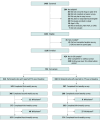Fentanyl Test Strip Use and Overdose Risk Reduction Behaviors Among People Who Use Drugs
- PMID: 40358945
- PMCID: PMC12076174
- DOI: 10.1001/jamanetworkopen.2025.10077
Fentanyl Test Strip Use and Overdose Risk Reduction Behaviors Among People Who Use Drugs
Abstract
Importance: Illegal fentanyl is driving overdose mortality, and fentanyl test strips (FTS) can be used to test drugs for fentanyl at the point of consumption. Evidence on whether FTS use is associated with overdose risk reduction behaviors is encouraging, but largely limited to smaller, single-site studies.
Objective: To determine whether self-reported baseline FTS use among people who use drugs (PWUD) was associated with overdose risk reduction behaviors and nonfatal overdose over a 28-day follow-up.
Design, setting, and participants: Multisite, observational cohort study of PWUD conducted from May to December 2023 as an ancillary study of the HEALing Communities Study, which consists of fixed and mobile direct service provision sites in 14 community partner organizations distributing FTS. Participants lived in Kentucky, New York, or Ohio and reported using heroin, fentanyl, cocaine, methamphetamine, or nonprescribed opioids, benzodiazepines, or stimulants within 30 days before baseline. Participants were followed up for a maximum of 37 days.
Exposure: Baseline FTS use.
Main outcome and measures: The primary outcome was a composite score measuring the self-reported number and frequency of using 8 overdose risk reduction behaviors. Secondary outcomes included multiple measures (eg, self-reported nonfatal overdose).
Results: The study included 732 participants (median [IQR] age, 41 [34.0-48.0] years; 369 [50.4%] male; 64 [8.9%] Black or African American, 587 [81.3%] White, and 71 [9.8%] other races); 414 reported baseline FTS use and 318 did not. Compared with nonusers, a higher percentage of baseline FTS users were from Ohio and White, while a lower percentage were from New York and Hispanic and/or Black. In adjusted analyses, PWUD who used FTS had a mean daily composite score for overdose risk reduction behaviors that was 0.86 (95% CI, 0.34-1.38) units higher across follow-up compared with nonusers (score for FTS users, 7.37; nonusers, 6.51). There was no difference in self-reported nonfatal overdoses between the 2 groups (mean daily risk for FTS users, 0.02; nonusers, 0.02; risk ratio, 1.20; 95% CI, 0.70-2.06).
Conclusions and relevance: In this cohort study, baseline FTS use was associated with greater engagement in overdose risk reduction behaviors during follow-up, but not with the risk of nonfatal overdose during follow-up, suggesting PWUD who use FTS may also engage in a broader set of harm reduction strategies.
Conflict of interest statement
Figures
References
Publication types
MeSH terms
Substances
Grants and funding
LinkOut - more resources
Full Text Sources


